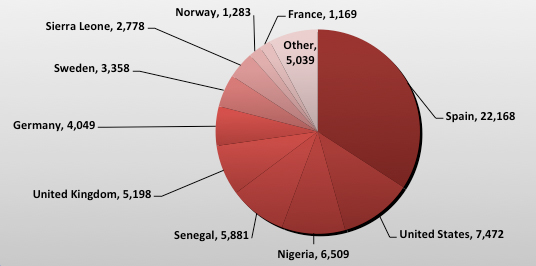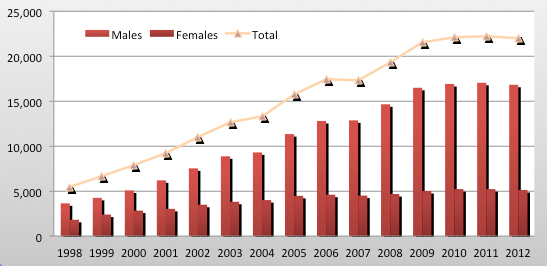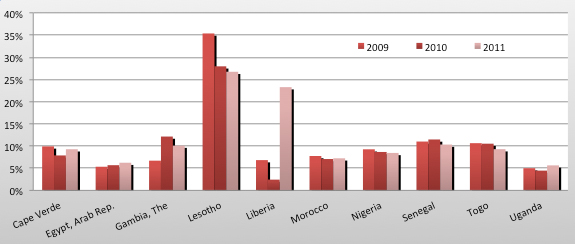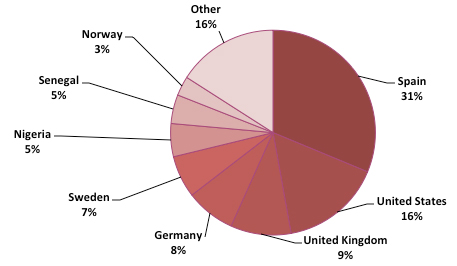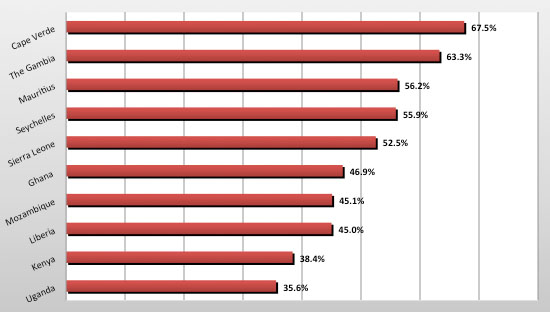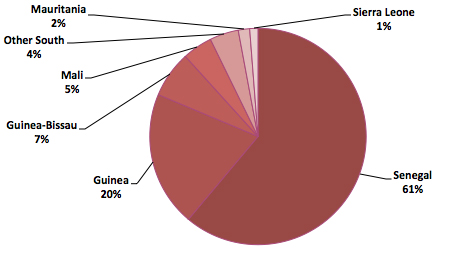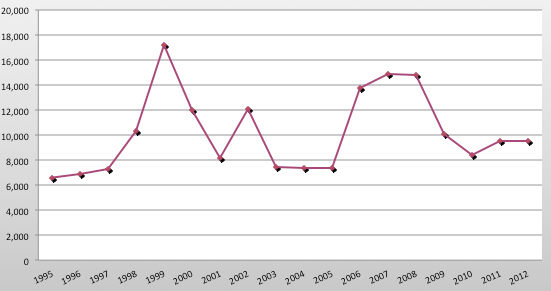The Gambia: Migration in Africa's "Smiling Coast"
There has been a long tradition of migration in the tiny West African nation The Gambia due to its geographic location, which has drawn international trade, wars, and conquests throughout history. The Senegambia region was one of the main transit points for the transatlantic slave trades between the 15th and 20th centuries, during which some 12 million slaves were forced from Africa to the Americas. Today, The Gambia is the smallest country on the African continent, with notable flows of both internal and international migrants.
Since gaining independence from Britain in 1965, economic turmoil has been a primary driver of these flows. Between 1993 and 2010, the urban population increased from about 37 percent to 58 percent of the total population, largely driven by young Gambians in rural areas migrating to urban areas in search of work.
The Gambian government’s inability to restore economic stability — including rectifying high unemployment especially among youth — has resulted in increased emigration among all segments of the population, in particular nurses and doctors. With approximately 65,000 Gambians abroad in 2010 (or around 4 percent of the total population), the country’s emigrant stock is small compared to other African countries. However, its skilled emigration rate (63 percent in 2000) was ranked among the top 20 worldwide and the second highest among African countries. Emigrants from The Gambia — both skilled and unskilled — send high levels of remittances home, but historically, the contributions of the Gambian diaspora have not been recognized by the Gambian government. In recent years, however, the Gambian government has begun to reach out to its citizens abroad, who mainly reside in Spain, the United States, Nigeria, Senegal, and the United Kingdom.
The Gambia is also a destination country for immigrants from other regions in Africa — the immigrant population comprised nearly 17 percent of the total population in 2010, often refugees during times of conflict but also a small number of skilled African migrants. It is also an important transit country for unauthorized migrants from sub-Saharan Africa en route for Europe.
This article explores The Gambia’s migration history, emigration and immigration trends, remittances, economic impacts of skilled emigration, and recent efforts by the government to reach out to the Gambian diaspora.
Historical Overview
During the 11th and 12th centuries, the Mandingos — the largest ethnic group in The Gambia comprising around 42 percent of the total population — migrated to the Senegambia region from present-day Mali. The next largest ethnic group, the Fulanis (around 18 percent) continue to migrate as nomads in search of pastures for their cattle, while the Wolofs (around 16 percent) migrated west to The Gambia and Senegal from Mali following the defeat of the Empire of the Ghana sometime before the end of the 13th century. Although English is the official language, each ethnic group of this country’s highly diverse, majority Muslim population of 1.9 million maintains its own local language and traditions.
During the decades-long transatlantic slave trade, Europeans did not travel inland in the Senegambia region to purchase or capture slaves (as was the case in other West African countries), but instead used African intermediaries such as chiefs and tribal leaders to buy slaves in exchange for European goods such as guns, gunpowder, and spices.
Estimates of slave outflows from the Senegambia region vary. Historian Philip D. Curtin estimated that from 1681 to 1810, a total of 304,330 slaves were forced to leave the region. Outflows between 1724 and 1735 (around 4,090 slaves per year) were higher than those estimated for the 1793 to 1800 period (around 1,000 per year). Historian Boubacar Barry estimates that throughout the 18th century, 6,000 slaves per year were forced to leave the Senegambia region. Francis Moore, a British mercantilist who lived near the Gambia River — the country’s namesake — in the 1730s, wrote that African slaves were shackled by the neck with leather tongs in lines of 30 to 40 people holding ivory or a bundle of corn in each hand.
Modern Migration Trends, Economic Downturn
Internal, regional, and international migration continued into the 19th century and the first half of the 20th century, driven largely by ethnic and religious conflicts or the slave trade. Prior to and after independence in 1965, many Gambians migrated to the United Kingdom to study and work. This group of Gambians included the first leader of The Gambia, Alhaji Sir Dawda Kairaba Jawara, who served as prime minister from 1962 to 1970 and then as president from 1970 to 1994. He initially trained as a veterinary surgeon at the Glasgow Veterinary School and later completed his training at Liverpool University. However, Parliament began enacting policies to limit immigration in the 1960s and 1970s — a trend which has continued and intensified into the 21st century.
The Gambia began facing economic difficulties almost immediately after independence in 1965, particularly in the agricultural sector which employed a vast majority of the population and was the principal source of export revenue (and still is today). Land resource scarcity — exacerbated by population growth — impacted the entire country and rural areas in particular.
In addition, deforestation and increased land exploitation contributed to widespread erosion. In the 1970s and 1980s, The Gambia was affected by severe droughts, and the price of peanuts — the main agricultural staple — continued to fall in the international market.
In the mid-1980s, The Gambia implemented the Economic Recovery Program (ERP) with the assistance of the World Bank, the International Monetary Fund (IMF), and other international donors with the aim of halting economic deterioration and laying the foundation for sustained economic growth. The ERP eliminated government subsidies, disposed of state-owned enterprises, and increased tax revenues, among other things. While the ERP helped the Gambian government’s finances, it did very little for ordinary Gambians, especially farmers in rural areas who depended on government subsidies, including seed and fertilizer subsidies. Moreover, rising consumer prices in the world markets, especially on food products such as rice (which is mostly imported in Gambia), led to a renewed dependence on subsistence farming.
By the end of the 1980s, rural-to-urban migration and especially emigration to Europe and North America had become common coping strategies — and enduring ones. Faced with low remuneration, lack of job security, and poor management of the health-care system, many Gambians, especially those working or aspiring to work in the medical field, began moving abroad for better opportunities.
The 1994 military coup — during which current president Yahya Jammeh took power — caused an increase in asylum seekers, and so prompted the United Kingdom and other European countries to require Gambians to obtain a visa before travelling. However, despite the tightening of immigration policies and enforcement, large numbers of young Gambian men continued to migrate to Europe, legally and illegally, in search of better opportunities.
Emigration Trends
The number of Gambians living abroad increased from approximately 35,000 in 2000 to approximately 65,000 in 2010 (though some estimates quote up to 90,000) (see Figure 1). Although small when compared to migrant stocks from other sub-Saharan African countries, The Gambia’s net migration rate in 2013 (-2.34 migrants/1,000 population) is the tenth highest in Africa.
Spain is the leading destination country for Gambian migrants with an estimated 22,000 Gambian nationals residing there in 2012. Other popular destination countries in order of importance include the United States, Nigeria, Senegal, the United Kingdom, and Germany (see Figure 1).
|
|
||
|
Gambians in Spain
While there are no historic, cultural, or trade ties between Spain and The Gambia, the total number of Gambians in Spain has grown steadily for the past two decades, in part because of geographic proximity (see Figure 2). Gambians are dispersed across the various regions, with the largest concentrations in Catalonia, Aragon, and Andalucía. Catalonia has by far the highest concentration of Gambians, accounting for over two-thirds of the total Gambian population in Spain.
Gambian migration to Spain spans over three migration periods, starting at the end of the 1970s and driven largely by post-independence economic deterioration. The worsening economic conditions and drought in the early 1980s prompted more Gambians to migrate during the following decade. The third wave of Gambian migrants arrived in the 1990s mainly for family reunification but also to seek refuge after the 1994 military coup.
Although estimates are not available, likely a large number of unauthorized Gambians currently reside in Spain, having arrived clandestinely by boat or overstayed their visas. These migrants face treacherous conditions along the way, including unscrupulous smugglers who charge exorbitant fees and often exploit migrants’ hopes and trust. Hundreds of migrants, including many Gambians, die each year while attempting to reach Spain by sailing in simple wooden fishing boats. For example, in 2007, some 50 African migrants, including Gambians, Senegalese, Malians, and Guineans died while trying to reach Spain. Their vessel lost power and supplies were low, resulting in some of the migrants being thrown overboard.
Immigration to Spain slowed significantly after the onset of the global economic crisis in late 2007 and the resulting rise in unemployment. According to the Spanish Statistical Office, the total number of residents fell by 206,000 in 2012 — a figure largely accounted for by the fall in the number of registered foreign-born residents. Similarly, the Gambian population in Spain fell slightly from 2011 to 2012, after a sustained increase which began in 1998 (see Figure 2).
Like many other migrants who arrive in Spain with hope for better opportunities, Gambian migrants often have very poor living conditions, residing in makeshift shelters with poor nourishment and hygiene. According to recent Spanish media reports, encampments in the woods in the southern Spanish province of Andalucía are home to some 10,000 migrants mainly from sub-Saharan Africa. Many Gambian migrants work in low-paid agricultural jobs, while others are employed in domestic services, construction, or the service industry.
|
|
||
|
Unlike Gambian immigrants in the United States and the United Kingdom, Gambian immigrants in Spain are less educated, perhaps because many come from the rural parts of The Gambia where education opportunities are limited. According to a 2005 study by researcher Adriana Kaplan Marcusán, the shares of female and male Senegalese and Gambian migrants in Spain who are illiterate are 83 percent and 72 percent, respectively.
Gambians in the United States
The second most popular destination for Gambian migrants is the United States, where about 7,500 resided in 2010 (although unofficial estimates are nearly double). Their share of the total African immigrant population in the country (about 1.6 million in 2011) is miniscule.
The majority of Gambians in the United States arrived in the 1990s, due in part to the 1994 military coup. Although Gambians are dispersed across the United States, they are concentrated in New York, Maryland, North Carolina, Washington, Georgia, Minnesota, and Kentucky.
U.S. State Department statistics indicate that from 2003 to 2012, 21,942 visas — including 20,227 nonimmigrant visas, i.e. students, tourists, and those visiting for business purposes, and 1,715 immigrant visas — were issued to Gambians (Table 1).
|
|
||||||||||||||||||||||||||||||||||||||||||||||||||
|
Despite small variations between 2003 and 2012, overall an increasing number of Gambian immigrants have been either granted lawful permanent resident (LPR) status (also known as obtaining a green card) or became naturalized citizens (see Table 2) during that period. Of the 1,159 Gambian immigrants who were granted green cards in 2012, about 70 percent did so through immediate relatives of U.S. citizens (higher than the average for all African immigrants). About 19 percent obtained green cards as refugees and asylees. A small percentage obtained green cards through family-sponsored preferences and employment-based preferences.
Like other African immigrants in the United States, Gambian immigrants are generally well educated. Conversations with Gambian diaspora organizations suggest that the majority of Gambian immigrants completed high school and also obtained a college education (either before or after migrating to the United States).
|
|
||||||||||||||||||||||||||||||||||||||
|
Remittances
During the past few years, incoming remittances as a share of gross domestic product (GDP) in The Gambia has been among the highest in Africa (see Figure 3).
|
|
||
|
According to IMF estimates, incoming remittances for The Gambia in 2010 were $90.7 million while outgoing remittances were reported at $33.3 million. This is equivalent to 10.1 percent and 3.7 percent of the country’s gross domestic product (GDP), respectively. Estimates of incoming remittances for 2007-11 averaged $81.3 million annually. However, these figures do not include the likely very large amount of money transferred through unofficial channels.
Incoming remittances in 2011 were more than twice the size of foreign direct investment (FDI) flows, $90.7 million versus $35.9 million. Incoming remittances are roughly equivalent to net official development assistance (ODA) and official aid to The Gambia. While FDI has decreased since the onset of the recent global economic crisis, remittances have not.
In 2012, most remittance inflows originated from Spain, the United States, the United Kingdom, and Germany (see Figure 4).
|
|
||
|
Migration and Development Considerations
The development-related benefits of migrants’ remittances are well documented and include helping alleviate poverty, especially for households without access to government support. However, on the flip side of this phenomenon is large-scale emigration of tertiary-educated workers, especially doctors and nurses, whose skills are fundamental to national development.
According to researchers Frédéric Docquier and Abdeslam Marfouk, in 2000 (the most recent year for which data are available), The Gambia had the second largest emigration rate of tertiary-educated population in sub-Saharan Africa (63 percent), behind Cape Verde (67.5 percent) (see Figure 5).
|
|
||
|
Moreover, data compiled by researchers Michael Clemens and Gunilla Pettersson indicated that 53 percent of all physicians and 66 percent of all professional nurses born in The Gambia were practicing outside the country in 2000. Over half of both groups were practicing in the United States, and the remainder in the United Kingdom and other European countries. Most of these professionals presumably had completed their education abroad, as The Gambia did not have any medical school programs and only limited nurse training until recently (the first trained doctors graduated from the University of The Gambia in 2007).
Although Gambian nurses and doctors often enjoy better salaries and job opportunities in Western countries, many may face deskilling — for example, a Gambian doctor whose diploma is not recognized in the United States and instead takes a job as a taxi driver or gas station attendant.
The Gambia as a Destination and Transit Country
In 2010, The Gambia’s immigrant population was approximately 290,000, or 16 percent of the total population. Most immigrants arrive from other African countries, mainly neighboring Senegal (61 percent), Guinea (20 percent), Guinea-Bissau (7 percent), and Mali (4 percent) (see Figure 6). Many are petty traders along the streets of the capital city Banjul and other major towns.
|
|
||
|
The Gambia’s role as a destination country has evolved over time and has largely been tied to conflicts in West Africa (see Figure 7). Sierra Leone’s civil war (1991–2002) and the Liberian civil wars (1989-96 and 1999-2003) displaced hundreds of thousands of people, many seeking refuge in nearby countries including The Gambia. The decades-long Casamance conflict has also left over 60,000 people displaced, with up to 10,000 in The Gambia and Guinea-Bissau. The 2012 Tuareg-led uprising in Mali and military coups in Guinea in 2008 and Guinea-Bissau in 2012 have also contributed to the number of refugees in The Gambia.
According to estimates from the United Nations High Commissioner for Refugees (UNHCR), The Gambia had 9,528 refugees (up to 11,000 according to local non-governmental organizations) and no asylum seekers in January 2013. The majority of refugees are from Liberia, Senegal, and Sierra Leone. Senegalese refugees, mainly from the Casamance region, often live with relatives in villages along the Senegal-Gambia border. Most Sierra Leonean and Liberian refugees live in urban areas of The Gambia. Although the Gambian government allows Casamance refugees to live and work in the country, successful integration often remains a challenge because many refugees — and their host families, especially in rural areas — commonly struggle with food insecurity, poor health, and insufficient housing.
|
|
||
|
There are also small numbers of highly-educated immigrants from Sierra Leone (mostly refugees), Nigeria, and Ghana who study, work in higher education, or provide technical support in information technology in The Gambia.
Due to its geographic location, The Gambia is also a major gateway for irregular transit migrants from sub-Saharan Africa en route for Europe. These migrants often work in The Gambia until they find their way to North Africa and ultimately Europe.
The Gambian Diaspora
There are currently dozens of diaspora associations in the United States, Spain, and other major destination countries for Gambian migrants. Among the most prominent are The Gambian American Association of greater Washington DC, Atlanta Gambia Emergency Relief Association (Agera), Seattle Gambian Association, Gambia United Society (United Kingdom), and Gambians in Finland Association. The main goal of these associations is addressing the welfare of Gambians in their respective communities.
The Gambian government has only very recently begun reaching out to and recognizing the contributions of its citizens abroad. In 2012, the mandate of the Ministry of Foreign Affairs, International Cooperation and Gambians Abroad was expanded to take on directly all diaspora affairs. Previously, there was no centralized, official agency dealing with these issues.
In addition, during the Gambian government’s first-ever consultative meeting in 2012 with diaspora representatives, Vice President and Minister of Women’s Affairs Aja Dr. Isatou Njie-Saidy recognized that the Gambian diaspora could play a significant role in the country’s economic development strategy. This was the first time any Gambian official had voiced such recognition.
Previously, there was little interaction and longstanding tension between the Gambian government and its diaspora. This rigidity drew from the dissatisfaction of Gambians abroad with economic and political conditions back home, as well as the perception that their government did not recognize or value their indirect contributions to national development by way of remittances and other engagement.
Although the Gambian government has recently initiated a dialogue with its citizens abroad, it remains unclear whether Gambian officials will take concrete steps to address diaspora issues. Following the consultative meeting, no policy recommendations or other actions followed up, much to the dismay of Gambian diaspora associations who continue to advocate for greater engagement with their home-country government.
Migration Policies
At the time of the writing of this article, The Gambia did not have a comprehensive migration policy but instead dealt with issues such as illegal immigration on a case-by-case basis. Although in 2006 the governments of The Gambia and Spain signed an immigration agreement aimed to control illegal immigration, many argue that the agreement did not go far enough as more young Gambians continued their attempt to enter Spain illegally. For example, in 2008 a Spanish plane deporting more than 100 unauthorized migrants to The Gambia was forced to return to Spain with all passengers still on board, after Gambian authorities refused to let the deportees disembark. In addition, a pact aimed at combating illegal migration through capacity building of the Gambian immigration personnel was signed between the Gambia and Italy in 2013.
The Gambia is a signatory of the 1951 Convention Relating to the Status of Refugees (1951 Convention) and its 1967 Protocol, but maintains reservations on its clauses providing exemptions for refugees from exceptional and provisional measures, the right to work, labor protection, social security, and administrative assistance. The Gambia also signed the 1969 Convention Governing the Specific Aspects of Refugee Problems in Africa. Recognizing The Gambia as a destination for West African refugees, deputies of the Gambian National Assembly in 2008 unanimously passed a Refugee Bill, which established The Gambia Commission for Refugees, a body that is tasked with coordinating and managing policy matters relating to refugee affairs in the country.
Ongoing Concerns, Future Issues
One central concern for many Gambian migrants and their families is efficient regulation of the money transfer market which currently lacks competition, leaving the cost of remitting earnings virtually unchecked. Poor regulation of this market also poses a challenge in terms of collecting accurate data on remittances — and development efforts that rely on these data. Many Gambian migrants choose informal channels for remitting their earnings because of the high costs of doing so through legal channels.
Many remittance-receiving countries around the world have begun working with commercial banks to develop special products and services such as allowing mortgage payments, bill payments, and school fees to go through flexible foreign-exchange accounts. This arrangement is beneficial because it allows migrants to engage in important economic activities without having to travel home, thus maintaining the volume of remittances. In addition, many governments around the world encourage migrants and their families to hold remittances in checking or saving accounts, because these are more secure, can earn interest, and can be directed toward business investment and education. As of the writing of this article, no such initiatives had been undertaken in The Gambia.
Microcredit — small loans issued to households in developing countries to fund small business enterprise and investment — remains a relatively unexplored industry in The Gambia. Although the benefits for migrant households are complex (see The Growing Linkages Between Migration and Microfinance), there is a potential link between migration and microcredit in the framework of a broader development strategy, if regulated with certain precautions.
Further, there is potential for increased cooperation between the Gambian diaspora, Gambian international civil servants working abroad, and Gambian diplomatic missions across the globe. Similar to the Philippines, the Gambian government could create an overseas employment administration to protect the rights, interests, and welfare of its citizens abroad.
One challenge looking forward will be managing and encouraging legal migration, especially for young Gambians who risk their lives with hope for better livelihoods in Europe. Because a major push factor is lack of opportunity for The Gambia’s best and brightest, improving skills training and higher education, coupled with efforts to improve overall job prospects, is also a major policy priority which has received scant serious attention from Gambian officials. Managing and encouraging legal migration is also important in achieving President Jammeh’s Vision 2020, a blue print for economic development for The Gambia aimed at transforming the country into, among other things, a financial center, a tourist paradise, and a trade- and export-oriented agricultural and manufacturing nation.
President Jammeh, who has remained in power since the 1994 military coup, has taken steps to address socioeconomic development, including the Program for Accelerated Growth and Employment (PAGE) 2012-15, which aims to increase employment and reduce poverty. However, until economic prospects improve significantly, the country will likely continue to see many of its most talented citizens leave.
*C. Omar Kebbeh is an economist from The Gambia. He currently works for the Bureau of Economic Analysis (BEA), U.S. Department of Commerce. His research is in the areas of economic development, international trade, migration, and remittances.
Sources
Barry, Boubacarr. 1998. Senegambia and the Atlantic Slave Trade. Cambridge: Cambridge University Press.
Central Intelligence Agency. 2013. The World Factbook. Available online.
Clemens, Michael and Gunilla Pettersson. 2006. Medical Leave: A new database of health professional emigration from Africa. Working Paper Number 95, August 2006. Washington, DC: Center for Global Development. Available online.
Curtin, Philip. 1969. The Atlantic Slave Trade: A Census. Madison: University of Wisconsin Press.
Daley, Suzanne. 2011. The New York Times. Chasing Riches from Africa to Europe and Finding Only Squalor. May 25, 2011. Available online.
Docquier, Frédéric and Abdeslam Marfouk. 2006. Measuring International Migration by Educational Attainment, 1990-2000: International Migration, Remittances and the Brain Drain. New York: McMillan and Palgrave. 151-99. Available online.
Haley, Alex. 1976. Roots: The Saga of an American Family. New York: Doubleday.
Hopkins, Gail. 2011. Casamance Refugees in The Gambia: Self-Settlement and the Challenges of Integration. UNHCR Research Paper No. 220, September 2011. Available online.
Hughes, Arnold and David Perfect. 2008. Historical Dictionary of The Gambia (Historical Dictionaries of Africa). Lanham: Scarecrow Press Inc.
Marcusán, Adriana Kaplan. 2005. From Senegambia to Spain: Migration Process and Social Integration. Monograph Migration: European Journal of International Migration and Ethnic Relations 43-45. pp. 52-65. Available online.
Orti, Fionaz. Spain's population falls as immigrants flee crisis. Reuters. April 22, 2013. Available online.
Spanish Statistical Institute (Instituto Nacional de Estadistica). Available online.
The World Bank. 2010. Global Bilateral Migration. Available online.
United Nations High Commissioner for Refugees (UNHCR). 2011. UNHCR Statistical Yearbooks. Available online.
U.S. Census Bureau. 2011. American Community Survey. Available online.
U.S. Committee for Refugees and Immigrants. 2008. World Refugee Survey 2008 – Gambia. June 19, 2008. Available online.
U.S. Department of State. 2012. Report of the Visa Office. Available online.
Weil, Peter. 1984. Slavery, Groundnuts, and European Capitalism in the Wuli Kingdom of Senegambia, 1820-1930. Research in Economic Anthropology 6: 77-119. Available online.
Woolls, Daniel. 2007. The Sun. Nearly 50 Die Trying to Reach Spain. November 7, 2007. Available online.



